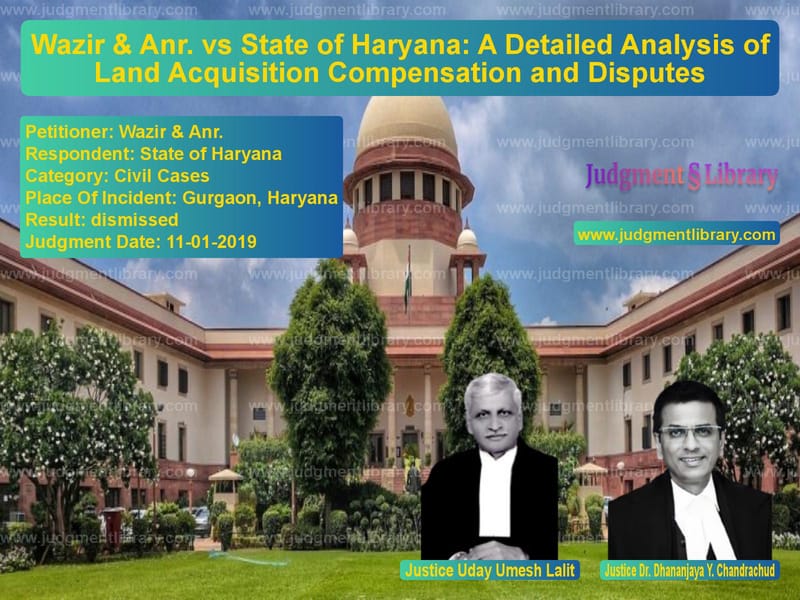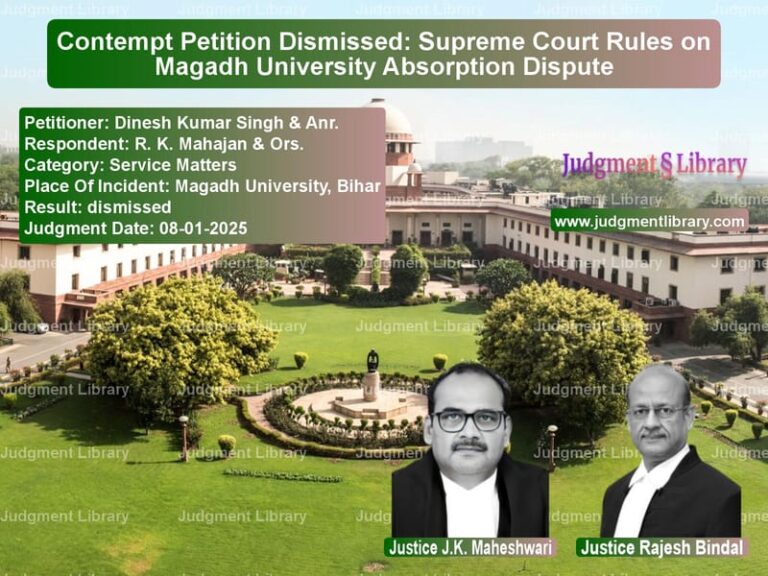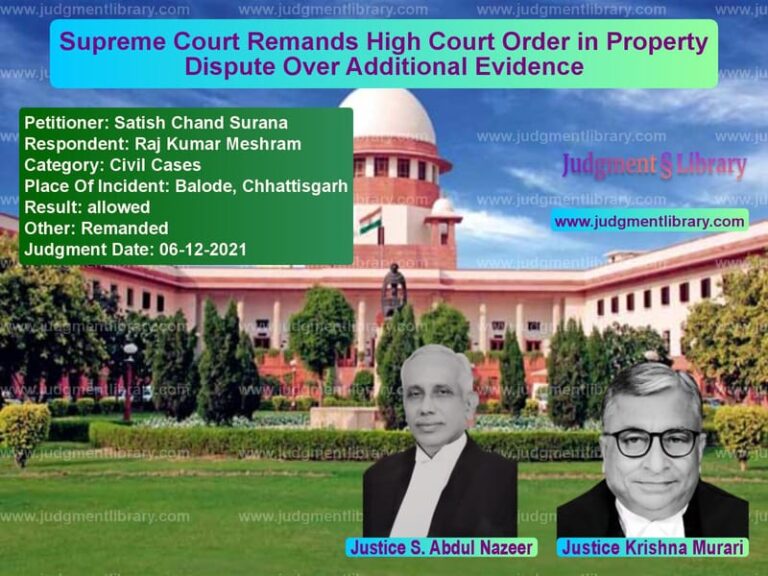Wazir & Anr. vs State of Haryana: A Detailed Analysis of Land Acquisition Compensation and Disputes
The case of Wazir & Anr. vs State of Haryana revolves around disputes related to the compensation awarded for land acquired by the Haryana State Industrial and Infrastructure Development Corporation (HSIIDC) for the development of the Industrial Model Township, Manesar, Gurgaon. In this judgment, the Supreme Court of India considered several appeals and cross-appeals concerning the compensation rates, escalation factors, and legal issues surrounding land acquisition under the Land Acquisition Act, 1894.
The dispute stems from the land acquisition process for the development of an industrial township in multiple phases. Over 1500 acres of land were notified for acquisition, and various challenges were raised by the landowners and the HSIIDC, particularly regarding the assessment of compensation and the methodology used to calculate the value of the acquired lands.
The petitioners, the landowners, argued that the compensation offered by the HSIIDC was inadequate and did not reflect the current market value of the land. They contended that the process of acquiring the land was flawed, with several procedural lapses and discrepancies in the evaluation of the land’s worth. Furthermore, they claimed that the escalation factor, which is a vital part of the compensation formula, was not correctly applied in their cases, leading to a grossly undervalued settlement.
The HSIIDC, on the other hand, argued that the compensation was calculated in accordance with the Land Acquisition Act, which provided a clear method for determining compensation rates based on the land’s current usage, location, and other factors. They further contended that the escalation factor had been adequately considered in the land valuation process, and that the compensation offered was both fair and just.
In addition to the dispute over the compensation amount, several issues regarding the application of the Land Acquisition Act came into focus. The petitioners argued that the compensation should include additional benefits such as solatium and interest, which were not accounted for in the initial settlement. The question of whether the land should be valued based on its future potential or its present use was also debated in the court proceedings.
The Supreme Court’s involvement in this case was critical because it addressed several important legal questions related to land acquisition practices in India, particularly how compensation should be assessed and whether the rights of landowners are adequately protected during the process. The Court also considered whether the HSIIDC’s approach to the compensation process aligned with the broader objectives of the Land Acquisition Act, which aims to balance the interests of the state in acquiring land for public use and the rights of the affected landowners.
This case has far-reaching implications for how land acquisition disputes are handled in India, especially in urban development projects that require large amounts of land for industrial or infrastructural development. The outcome of this case could set a precedent for future land acquisition cases, particularly in terms of how compensation is calculated and whether additional compensation factors like solatium, interest, and market escalation are necessary for ensuring fairness.
The petitioner’s argument was based on the claim that the compensation formula failed to adequately reflect the increase in land value due to urbanization and development. They pointed out that the land they were losing was valuable not just for its agricultural use but also because it had tremendous future development potential due to its proximity to the rapidly growing urban area of Gurgaon. This claim was supported by market reports and expert opinions that indicated that land in the region was being sold at prices much higher than the compensation offered by the HSIIDC.
On the other hand, the HSIIDC maintained that the compensation calculation was based on fair market standards and had accounted for relevant factors such as the land’s current use and its market rate at the time of acquisition. They argued that land value should not be inflated by speculative expectations about future development potential, which were speculative and not guaranteed. They also emphasized that the compensation rate adhered strictly to the Land Acquisition Act and that there were no legal grounds for any additional payments.
One of the central issues in this case revolved around the escalation factor used to adjust compensation rates for the land acquired. The escalation factor is a mechanism meant to account for the changes in land prices over time, especially for lands that are acquired over an extended period. The petitioners argued that the escalation factor had not been correctly applied, leading to an undervaluation of the land’s current market price.
The Court had to address whether the escalation factor, as implemented by the HSIIDC, was adequate and properly applied. They also had to determine whether any additional compensation should be awarded for the disruption and hardship caused by the land acquisition process. Specifically, the petitioners asked for a larger sum to be included in the final compensation package to reflect not only the market value but also the increased social and economic cost of the land acquisition for the affected families.
The Court ultimately had to decide whether the compensation offered by the HSIIDC was fair and in line with the principles of justice enshrined in the Constitution. The question also arose as to whether the statutory framework governing land acquisition was adequate to ensure fairness for landowners, particularly when urban development projects involved land that had high future value potential.
The outcome of this case was eagerly awaited by both landowners and developers across India, as it had the potential to reshape how compensation was calculated for urban land acquisitions. Landowners hoped for a ruling that would increase the compensation for acquired lands in urban development projects, particularly in rapidly growing areas where land values could rise dramatically in a short period.
The Court’s ruling was expected to provide clarity on several critical issues, including whether land acquisition compensation should be based solely on the land’s present value or whether future development potential should be factored in. It was also anticipated that the ruling would provide guidance on the calculation of compensation escalation factors, especially in cases where land values change over time due to urbanization.
This judgment holds significant importance for future land acquisition proceedings in India, particularly in states like Haryana, where rapid urbanization has led to rising land values. Developers and real estate companies have been closely watching this case, as it will help establish the benchmarks for calculating compensation in future acquisitions for industrial or infrastructural development. The decision could also have implications for how government authorities handle disputes related to compensation in land acquisition matters, making it a landmark case in the domain of urban development and land acquisition law in India.
Petitioner Name: Wazir & Anr..Respondent Name: State of Haryana.Judgment By: Justice Uday Umesh Lalit, Justice Dr. Dhananjaya Y. Chandrachud.Place Of Incident: Gurgaon, Haryana.Judgment Date: 11-01-2019.
Don’t miss out on the full details! Download the complete judgment in PDF format below and gain valuable insights instantly!
Download Judgment: Wazir & Anr. vs State of Haryana Supreme Court of India Judgment Dated 11-01-2019.pdf
Direct Downlaod Judgment: Direct downlaod this Judgment
See all petitions in Property Disputes
See all petitions in Contract Disputes
See all petitions in Landlord-Tenant Disputes
See all petitions in Specific Performance
See all petitions in Debt Recovery
See all petitions in Judgment by Uday Umesh Lalit
See all petitions in Judgment by Dhananjaya Y Chandrachud
See all petitions in dismissed
See all petitions in supreme court of India judgments January 2019
See all petitions in 2019 judgments
See all posts in Civil Cases Category
See all allowed petitions in Civil Cases Category
See all Dismissed petitions in Civil Cases Category
See all partially allowed petitions in Civil Cases Category







